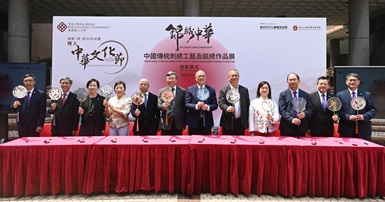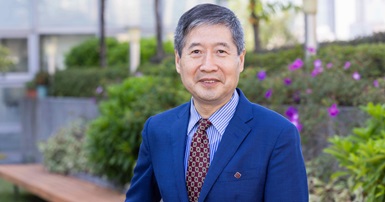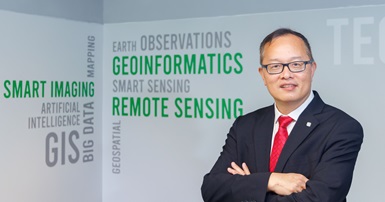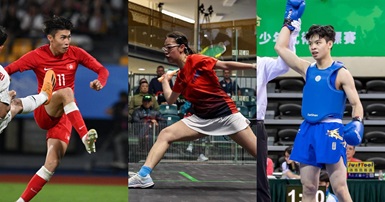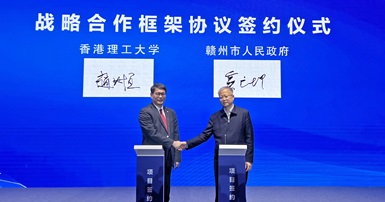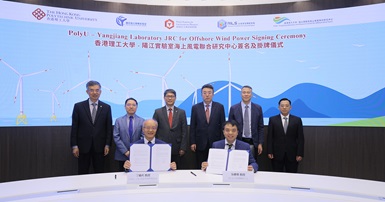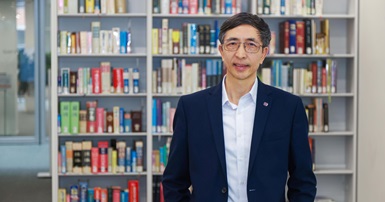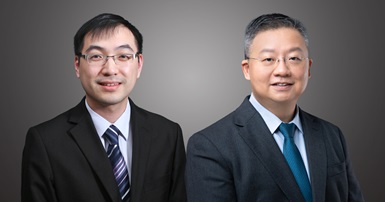PolyU joins forces with Wenzhou institution to promote vibrant Chinese embroidery arts and intangible cultural heritage at Chinese Culture Festival
The Hong Kong Polytechnic University (PolyU) is hosting the “Splendid China Embroidery - Traditional Chinese Embroidery Crafts and Ou Embroidery Works Exhibition” as part of its Chinese Culture Festival. Aiming to promote the national intangible cultural heritage, with expert lectures, workshops and guided tours, it runs from today until 23 April.
An opening ceremony for the Exhibition, co-organised by PolyU, the Wenzhou Municipal Culture, Radio, Television and Tourism Bureau, and the Zhejiang Industry and Trade Vocational College, was held today with officiating guests including Dr LAM Tai-fai, PolyU Council Chairman; Prof. Jin-Guang TENG, PolyU President; Mr ZHANG Zhihong, Party Secretary and First-level Researcher of the Wenzhou Municipal Culture, Radio, Television and Tourism Bureau; Prof. WANG Yan, Vice President of the Zhejiang Industry and Trade Vocational College; and Ms ZOU Shengzhu, Senior Arts and Crafts Artiest of Zhejiang Industry and Trade Vocational College, and Zhejiang Arts and Crafts Master. They were joined by Dr Katherine Ngan Ng Yu-ying, Court Chairman of PolyU; University senior management and faculty/school deans and other representatives.
Dr Lam Tai-fai remarked, “PolyU not only places great importance on scientific research but is also committed to promoting Chinese culture. Broad and profound, Chinese culture is our inheritance and requires careful preservation and promotion among the wider society. The PolyU Chinese Culture Festival aims to inspire broader appreciation of the charm and richness of Chinese culture, with a particular focus on the younger generation. Our goal is for them to develop a deeper understanding of our vibrant traditional culture, enabling them to explore, innovate and embrace the future. This will ultimately facilitate Hong Kong’s integration into the overall development of the Country and contribute to the development of both Hong Kong and our Nation.”
Mr Zhang Zhihong stated, “This exhibition brings together exceptional Ou embroidery works from all over the country. By employing technology, these pieces have been presented in an innovative way to promote the beauty of Chinese culture and traditional crafts. I sincerely hope this cultural exchange activity will serve as an opportunity for Wenzhou and Hong Kong to establish a new model of collaboration and exchange, fostering a closer cultural connection and deeper mutual understanding. I aspire for both cities to utilise the rich Chinese cultural heritage as a bridge to facilitate cultural exchanges, mutual learning and coordinated urban development.”
Prof. Wang Yan said, “I am deeply honoured to have been invited to exhibit our Ou embroidery works, which are a part of our national intangible cultural heritage, at PolyU. I hope that through the exhibition and workshops, more friends from Hong Kong can experience the unique charm and contemporary value of Chinese culture. Moving forward, our College is committed to strengthening cooperation and exchanges with the PolyU-Wenzhou Technology and Innovation Research Institute, further deepening multifaceted collaboration in areas such as academic exchange, talent cultivation, research and innovation, and cultural inheritance to propel the creative transformation of our traditional culture.”
Embroidery, one of China’s ancient handicrafts, holds profound cultural significance and historical value. In ancient times, Wenzhou in Zhejiang province, was known as the Dong’ou kingdom, a region renowned for its thriving sericulture and silk industries, which contributed to the flourishing of Ou embroidery craftsmanship. Recognised as a national intangible cultural heritage, Ou embroidery showcases exceptional artistry, folklore and economic value. This exhibition proudly displays a diverse collection of Ou embroidery artworks across the PolyU campus and in Hotel ICON, the teaching and research hotel built for the University’s School of Hotel and Tourism Management.
To enhance the visitor experience, selected exhibition zones imaginatively combine traditional culture and technology, incorporating vivid light and colour technologies contributed by Prof. Tommy Minchen WEI, Professor of the Department of Building Environment and Energy Engineering and Director of the Colour Imaging and Metaverse Research Centre at PolyU, to highlight the beauty of the embroidery craftsmanship. Augmented reality technology will be also employed to enrich the viewing experience of exhibits at certain zones.
Ms Zou Shengzhu, Senior Arts and Crafts Artiest of Zhejiang Industry and Trade Vocational College and Zhejiang Arts and Crafts Master, introduced the Ou embroidery exhibits in a guided tour.
In addition to the Exhibition, there are workshops designed to reveal the skills of Ou embroidery, fostering an appreciation for the culture and excellence in craftsmanship.
In addition to the Exhibition, there will be two lectures, workshops and guided tours hosted by Ms ZOU Shengzhu, Senior Arts and Crafts Artiest of Zhejiang Industry and Trade Vocational College, and Zhejiang Arts and Crafts Master, all of which will be open to PolyU students, staff, alumni and the public free of charge. These activities are designed to reveal the skills of Ou embroidery, fostering an appreciation for the culture and excellence in craftsmanship, while also enhancing the participants’ artistic sensitivity, insight, aesthetics and creativity. Additionally, a voting activity will also be organised for “My Favourite Ou Embroidery Artwork” to help further engage visitors.
Another upcoming activity will be the “Indigo Dyeing from the Blue - The Silk Road Textile Dyeing Enters Hong Kong” exhibition to be held between 30 May and 13 June. In collaboration with the College of Art of Beijing Union University, the exhibition will showcase a number of silk dyeing artworks from Prof. GUAN Lansheng, a fifth-generation representative inheritor of national intangible cultural heritage in textile dyeing* crafts and a professor from the College of Art of Beijing Union University.
To learn more about the PolyU Chinese Culture Festival and the “Splendid China Embroidery - Traditional Chinese Embroidery Crafts and Ou Embroidery Works Exhibition”, please visit the website or click here to obtain details and photos of featured exhibits.
*Remark: Textile dyeing refers to the general term for ancient silk printing and dyeing crafts. From a craft classification perspective, textile dyeing is divided into four categories: grey dyeing, resist dyeing, wax dyeing, and clamp dyeing.
*** END ***
Events
Research and Innovation Office
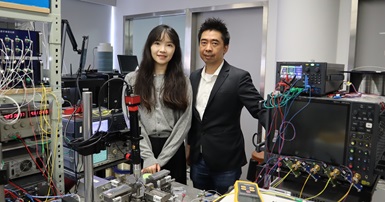
.jpg?bc=ffffff&h=202&w=385&hash=AF05AECEF9A5F6E3B51970762CB6763D)
